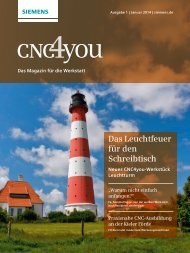spectrum
spectrum
spectrum
Create successful ePaper yourself
Turn your PDF publications into a flip-book with our unique Google optimized e-Paper software.
TMP, based in the ancient city of Voronezh,<br />
Russia, is the largest developer and builder of<br />
equipment for the country’s metal forging<br />
industries. In terms of world presence, of the 17 hot<br />
forging presses with pressure greater than 10,000 t<br />
in current operation across the globe, 8 were built<br />
by TMP. Because of the tough market conditions<br />
that the world’s machine tool builders are faced<br />
with, companies try especially hard to secure business<br />
in their own domestic markets. This is particularly<br />
so in the BRICs (Brazil, Russia, India, and China).<br />
Against this diffi cult backdrop, the Russian machine<br />
builder TMP was awarded a contract to build an<br />
innovative new hot steel rolling project in Brazil.<br />
The main task of this project was building a hot rolling<br />
press system, called Rollers. The Rollers produce<br />
one of the suspension details of trucks and consist<br />
of the hot rolling press with special manipulator, the<br />
system of transport of hot billet and other technological<br />
equipment. For this mill, TMP developed an<br />
intelligent automated handling system, called Rollers,<br />
to manipulate the hot working material.<br />
Automating complex procedures<br />
The technological algorithm of rollers is divided into<br />
several parts. First, the general receiving manipulator<br />
transfers a red-hot billet to the feed conveyer by an<br />
exactly defi ned path calculated according to the safety<br />
standards. The feed conveyer transfers the billet to the<br />
roller manipulator, which grips the billet and begins<br />
the multiple rolling process. Each roll has four deep<br />
grooves. A billet is rolled through couple rolls which<br />
are formed in the shape of a billet. Usually after four<br />
forming cycles, the roll manipulator transfers the billet<br />
to the outfeed conveyor, which in turn transfers the<br />
billet on to the next manufacturing stage. The control<br />
system within rollers performs a variety of important<br />
tasks. In addition to the precision movement of the<br />
working material, it controls system temperatures,<br />
the hydroelectric equipment, and braking control.<br />
The PLC also coordinates the functioning of the rollers<br />
with other systems such as the furnace and other<br />
handlers, with communication passing via Profi bus.<br />
Drive-based motion control platform<br />
The intelligent control driving the rollers is based on<br />
Simotion D435, a compact drive-based motion control<br />
platform combining motion control, logic control,<br />
and drive control within a single hardware<br />
environment. Simotion is the natural successor to<br />
earlier PLC approaches based on the S7-300 plat-<br />
form. Its greater power enables a larger volume of<br />
programs to be run simultaneously. For the main<br />
drive, Sinamics S120 was chosen. Sinamics S120 is<br />
a modular motion control drive system for complex<br />
tasks. It carries out the complex motion control of<br />
two axes of the roller manipulator, with each axis<br />
being equipped with 5 kW Simotics S-1FT6 motors.<br />
The distributed I/O system is an ET 200M station,<br />
connected to the Simotion D435 via Profi bus. The<br />
control provides the operators with system information<br />
such as the drive operating hours, number of<br />
cycles, axis drive currents, and fault reports. For the<br />
Rollers project the programs are written using<br />
Simotion Scout, the network topology is performed<br />
in NetPro, and the HMI is provided via WinCC Flexible.<br />
These different systems all integrate seamlessly<br />
with the hardware platform. The open system integration<br />
enabled the TMP engineers to clearly specify<br />
and implement scalable solutions for complex technological<br />
tasks.<br />
Variable behavior<br />
The main challenge in developing the rollers was the<br />
two-axis motion control of the roller manipulator.<br />
When a hot billet is rolled, its shape changes dramatically,<br />
with each billet behaving in a slightly different<br />
manner. Because of this variance, the precise position<br />
of the billet as it exits from the rollers cannot be<br />
predicted by mathematical modeling. In order to<br />
achieve accurate control of the handling, a motion<br />
control system with on-the-fl y switching of control<br />
algorithms for each axis was developed. The main<br />
principle of the algorithm is the capability to switch<br />
from master to slave mode on-the-fly. With the<br />
sophisticated control system implemented by TMP,<br />
the roller achieved a throughput of 130 billets per<br />
hour. This Rollers project was TMP’s first motion<br />
automation project using Simotion controls and<br />
Sinamics drives. Despite their relative lack of experience<br />
with this environment, the TMP engineers were<br />
successful in accomplishing an ambitious project<br />
that included the fast switching algorithms for the<br />
roller manipulator. The experience gained opens up<br />
opportunities for TMP in the development of further<br />
complex integrated machines. p<br />
info<br />
contact<br />
www.siemens.com/simotion<br />
alexey.taranchenko@siemens.com<br />
Siemens AG<br />
<strong>spectrum</strong> METAL FORMING 2012 21



